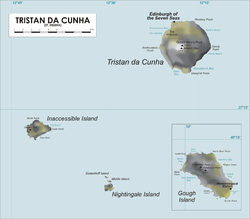
Nightingale Islands
Encyclopedia

Tristan da Cunha
Tristan da Cunha is a remote volcanic group of islands in the south Atlantic Ocean and the main island of that group. It is the most remote inhabited archipelago in the world, lying from the nearest land, South Africa, and from South America...
territory. They consist of Nightingale Island
Nightingale Island
Nightingale Island is an island in the South Atlantic Ocean, 3 km² in area, part of the Tristan da Cunha group of islands. They are administered by the United Kingdom as part of the overseas territory of Saint Helena, Ascension and Tristan da Cunha....
, Middle Island
Middle Island, Tristan da Cunha
Middle Island is a small, uninhabited island in the South Atlantic Ocean, part of the Nightingale Islands. They are governed as part of Tristan da Cunha, an archipelago that is part of the British overseas territory of Saint Helena, Ascension and Tristan da Cunha.-External links:*...
and Stoltenhoff Island
Stoltenhoff Island
Stoltenhoff Island is a small uninhabited island in the South Atlantic Ocean, part of the Nightingale Islands. It is the smallest of the Nightingale Islands, and is to the north west of Nightingale Island itself...
. The islands are administered by the United Kingdom
United Kingdom
The United Kingdom of Great Britain and Northern IrelandIn the United Kingdom and Dependencies, other languages have been officially recognised as legitimate autochthonous languages under the European Charter for Regional or Minority Languages...
as part of the overseas territory of Saint Helena, Ascension and Tristan da Cunha
Saint Helena, Ascension and Tristan da Cunha
Saint Helena, Ascension and Tristan da Cunha is a British overseas territory and overseas territory of the European Union consisting of the islands of Saint Helena, Ascension Island and the Tristan da Cunha group...
. The Nightingale Islands are uninhabited.
Nightingale Island is the smallest of the four main islands of the Tristan da Cunha Group, measuring only 4 square kilometres (1.5 sq mi), and lies 30 kilometres (18.6 mi) away from Tristan and 22 kilometres (13.7 mi) from Inaccessible. Stoltenhoff and Alex (also known as Middle Island), are really two large islets rather than conventional islands.
Originally named "Gebrooken Island" by the Dutch
Netherlands
The Netherlands is a constituent country of the Kingdom of the Netherlands, located mainly in North-West Europe and with several islands in the Caribbean. Mainland Netherlands borders the North Sea to the north and west, Belgium to the south, and Germany to the east, and shares maritime borders...
in 1666, they found no safe anchorage and did not make the first landing until 1696. Nightingale was renamed after British
United Kingdom
The United Kingdom of Great Britain and Northern IrelandIn the United Kingdom and Dependencies, other languages have been officially recognised as legitimate autochthonous languages under the European Charter for Regional or Minority Languages...
Captain Gamaliel Nightingale in 1760. Jonathan Lambert temporarily changed the name to "Lovel Island" in his 1811 proclamation in the "Boston Gazette" but as with his other proposed changes (ie. Tristan da Cunha Group to "Isles of Refreshment") the name did not last.
Wildlife
Nightingale, a tiny island, is home to more than 3 million pairs of seabirds and at a density of around 1.3 pairs per square metre, almost the entire vegetated island is occupied. Both the Nightingale and Wilkins' Bunting are found nowhere else in the world.For these reasons the island has been recognised internationally as: a Wetland
Wetland
A wetland is an area of land whose soil is saturated with water either permanently or seasonally. Wetlands are categorised by their characteristic vegetation, which is adapted to these unique soil conditions....
of International Importance under the Ramsar Convention
Ramsar Convention
The Ramsar Convention is an international treaty for the conservation and sustainable utilization of wetlands, i.e., to stem the progressive encroachment on and loss of wetlands now and in the future, recognizing the fundamental ecological functions of wetlands and their economic, cultural,...
; an Important Bird Area (IBA); and part of the Tristan da Cunha Endemic Bird Area (EBA).

